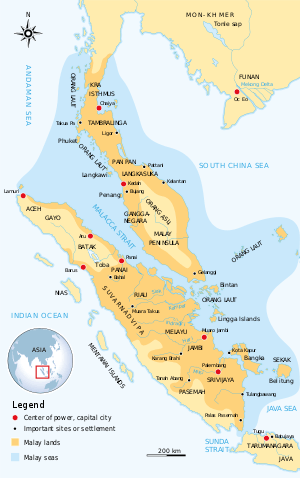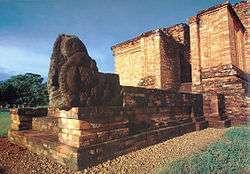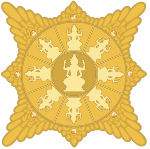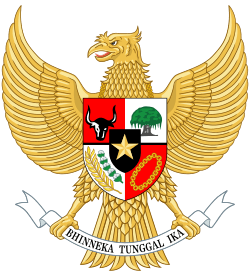Melayu Kingdom
The Melayu Kingdom (also known as Malayu, Dharmasraya Kingdom or the Jambi Kingdom; Chinese: 末羅瑜國; pinyin: Mòluóyú Guó, reconstructed Middle Chinese pronunciation mat-la-yu kwok)[1][2][3] was a classical Malay Buddhist kingdom located in Southeast Asia.

Part of a series on the |
||||||||||||||||||||||||||||||||||||||||||||||||||||||||||||||||||||||||
|---|---|---|---|---|---|---|---|---|---|---|---|---|---|---|---|---|---|---|---|---|---|---|---|---|---|---|---|---|---|---|---|---|---|---|---|---|---|---|---|---|---|---|---|---|---|---|---|---|---|---|---|---|---|---|---|---|---|---|---|---|---|---|---|---|---|---|---|---|---|---|---|---|
| History of Malaysia | ||||||||||||||||||||||||||||||||||||||||||||||||||||||||||||||||||||||||
 | ||||||||||||||||||||||||||||||||||||||||||||||||||||||||||||||||||||||||
|
Prehistoric Malaysia
|
||||||||||||||||||||||||||||||||||||||||||||||||||||||||||||||||||||||||
|
Early kingdoms
|
||||||||||||||||||||||||||||||||||||||||||||||||||||||||||||||||||||||||
|
Rise of Muslim states
|
||||||||||||||||||||||||||||||||||||||||||||||||||||||||||||||||||||||||
|
Colonial era
|
||||||||||||||||||||||||||||||||||||||||||||||||||||||||||||||||||||||||
|
World War II
|
||||||||||||||||||||||||||||||||||||||||||||||||||||||||||||||||||||||||
|
Formative era
|
||||||||||||||||||||||||||||||||||||||||||||||||||||||||||||||||||||||||
|
Barisan Nasional era
|
||||||||||||||||||||||||||||||||||||||||||||||||||||||||||||||||||||||||
|
Pakatan Harapan/Perikatan Nasional era
|
||||||||||||||||||||||||||||||||||||||||||||||||||||||||||||||||||||||||
|
Incidents
|
||||||||||||||||||||||||||||||||||||||||||||||||||||||||||||||||||||||||
|
| ||||||||||||||||||||||||||||||||||||||||||||||||||||||||||||||||||||||||
The primary sources for much of the information on the kingdom are the New History of the Tang, and the memoirs of the Chinese Buddhist monk Yijing who visited in 671, and states was "absorbed" by Srivijaya by 692, but had "broken away" by the end of the eleventh century according to Chao Jukua.[4]:79–80,83,142,179,184 The exact location of the kingdom is the subject of studies among historians. One theory is that the kingdom was established around present-day Jambi on Sumatra, Indonesia, approximately 300 km north of Palembang. According to this theory, it was founded by ethnic groups in the Batanghari river area and gold traders from the Minangkabau hinterland.[5] The theory is disputed as the geographical location of Jambi contradicts the descriptions by Yijing, who explicitly mentioned that the kingdom is located half-way between Ka-Cha (Kedah) and Bogha (Palembang)".[2]
Etymology
The origins of the word Melayu ('Malay') are disputed. One theory suggests that it is derived from the Javanese terms melayu or mlayu (to steadily accelerate or to run), to describe the strong current of a river in Sumatra that today bears the name Sungai Melayu ('Melayu river').[6] The name was later possibly adopted by the Melayu Kingdom, as it is common for people in the region to be known by the name of the river on which they settled.[7]
Another theory hold that it originates from the Tamil words Malai and ur meaning "mountain" and "city, land", respectively.[8][9][10]
An early literary appearance was in Vayu Purana where the word "Malaya Dvipa" (literally "mountainous dvipa") was mentioned, referring to the mountainous terrain of Malay Peninsula.[11][12][13][14][15] Then, the term "Maleu-Kolon" was used in Geographia by Ptolemy which is believed to have originated from the Sanskrit term malayakolam or malaikurram, referring to a geographical part of Malay Peninsula.[16]
In 7th century, the first use of the term for a nation or a kingdom was recorded by Yijing.
The East Javanese Anjukladang inscription dated from 937 CE Medang Kingdom stated the Sima status is awarded to Anjukladang village and a jayastambha (victory monument), which later upgraded as a temple, was erected in recognition of their service on repelling the invading forces from Malayu. The temple mentioned here is probably the Candi Lor made of bricks which is now in ruins, located in Candirejo village in Nganjuk Regency.[17] The mentioning of invading Malayu forces refer to the old name of Sumatran Malayu Kingdom, which probably refer to Srivijaya instead. This means by the 10th century, the Javanese identify their Sumatran-based enemy as "Malayu".
An inscription on the south wall of the 11th century Brihadeeswarar Temple also made a reference to Malaiyur, a kingdom that had "a strong mountain for its rampart" in Malay Peninsula that fell to the Chola invaders during Rajendra Chola I's campaign.[18]
In the later Yuan Dynasty (1271–1368) and Ming Dynasty (1368–1644), the word Ma-La-Yu was mentioned often in Chinese historical texts - with changes in spelling due to the time span between the dynasties - to refer to a nation near the southern sea. Among the terms used was "Bok-la-yu", "Mok-la-yu" (木剌由), Ma-li-yu-er (麻里予兒), Oo-lai-yu (巫来由) - traced from the written source of monk Xuanzang), and Wu-lai-yu (無来由). In the chronicle of Yuan Dynasty, the word "Ma-li-yu-er" was mentioned in describing the Sukhothai Kingdom's southward expansion against Malay states of the peninsula.:[19]
- "..Animosity occurred between Siam and Ma-li-yu-er with both killing each other..."
In response to the Sukhothai's move, a Chinese envoy arrived at the Ram Khamhaeng's court in 1295 bearing an imperial order: "Keep your promise and do no evil to Ma-li-yu-er".[20] This nation of "Ma-li-yu-er" that appeared in the Chinese record possibly a similar nation that was mentioned by the famous Venetian traveller Marco Polo (1254–1324) who lived during the same period. In Travels of Marco Polo, he made a reference to a kingdom named "Malauir" in the Malay peninsula.[21][22] The Khmer recorded the nation of Melayu, however, its progeny Srivijaya, was also called Melayu.
According to the translation by Slamet Muljana, the word bhūmi Mālayu (literally "Land of Malayu") is inscribed on the Padang Roco Inscription, dated 1286 CE,[23] according to the inscription, bhūmi Mālayu is associated with the Dharmasraya kingdom. On the Amoghapasa inscription, dated 1347 CE, the word Malayapura (literally "city of Malaya" or "kingdom of Malaya") was proclaimed by Adityawarman, again referring to Dharmasraya. The word "Melayu" is also mentioned in the Malay annals referring to a river in Sumatra:
- "...Here now is the story of a city called Palembang in the land of Andelas. It was ruled by Demang Lebar Daun, a descendant of Raja Shulan, and its river was the Muara Tatang. In the upper reaches of the Muara Tatang was a river called Melayu, and on that river was a hill called Si-Guntang Mahameru..."
Yijing's account
On his route via Maritime Southeast Asia, Yijing visited Srivijaya twice where he stayed from 688 to 695, studying and translating the original texts in Sanskrit. Srivijaya appears to have been flourishing around the time of Yijing's visit, which he initially called "Bogha" during his first visit. At its greatest extent, the kingdom extended to Malayu, which seems to have been annexed or to have come spontaneously under the realm of Bogha prince. The whole country as well as the capital received the name "Sribogha" or Srivijaya. The change of the name Malayu to Sribogha is likely to have occurred before Yijing's time or during his stay there, for whenever he mentions Malayu by name, he added that "it is now changed to Sribogha".[2]
The following extract from Yijing's work, A Record of Buddhist Practices Sent Home from the Southern Sea, further describes his route via Bogha and Malayu:
- Wu Hing came to Bogha after a month's sail. The king received him very favourably and respected him as a guest from the land of the son of heaven of the Great Tang. He went on board the king's ship to the country of Malayu and arrived there after fifteen days sail. Thence he went to Ka Cha, again after fifteen days. At the end of winter he changed ship and sailed to the west.
Further for the determination of the location of Sribogha-Malayu, Yijing furnishes the following:
- In the country of Sribogha, we see the shadow of the dial-plate become neither long nor short (i.e "remain unchanged" or "no shadow") in the middle of the eighth month (Autumnal equinox), and at midday no shadow falls from a man who is standing on that day, so it is in the middle of spring (Vernal equinox).
Thus it can be inferred that the country of Sribogha covered the place lying on the equator, and the whole county therefore must have covered the north east side of Sumatra, from the southern shore of Malacca, to the city of Palembang, extending at least five degrees, having the equatorial line at about the centre of the kingdom.
According to Yijing, Hinayana Buddhism was predominantly adopted in Srivijaya, represented for the most part by the Mulasarvastivada school, however there were few Mahayanists in Malayu. Gold seems to have been abundant in the kingdom, where people used to offer the Buddha a lotus flower of gold and used golden jars. Moreover, people of the kingdom wear a type of long cloth and used fragrant oil.[2]
Further, Melayu had accessed to gold producing areas in the hinterland of Sumatra. This slowly increased the prestige of Melayu which traded various local goods, including gold, with foreigners.
Center of Srivijaya

Between 1079 and 1088, Chinese records show that Srivijaya sent ambassadors from Jambi and Palembang.[24] In 1079 in particular, an ambassador from Jambi and Palembang each visited China. Jambi sent two more ambassadors to China in 1082 and 1088.[24] This suggests that the centre of Srivijaya frequently shifted between the two major cities during that period.[24] The Chola invasion of Srivijaya and as well as changing trade route weakened Palembang, allowing Jambi to take the leadership of Srivijaya from the 11th century on.[25]
Demise
In 1275, Kritanagara, of the Singhasari Kingdom, took advantage of Srivijaya's decline and sent a military expedition to establish Javanese control of Melayu. Embassies were sent to China in 1299 and 1301.[4]:198,203–204 Mahesa/Kebo/Lembu Anabrang was a General of Singhasari, who conquered Srivijaya and Melayu in 1288.
Almost a century after taking over Palembang's role as the centre of an empire, Jambi and Srivijaya experienced decline in influence.[26] This was caused by a change of policy by the Song dynasty to no longer accept ambassadors from Srivijaya and Jambi's inability to cope with changing scenario. Instead of the Jambi controlling the trade through tributary system, traders were allowed to trade directly.[27]
According to George Coedes, by the beginning of the fourteenth century, Melayu "remained the only Sumatranese state of some political importance and it had become the refuge of Indian culture in opposition to the sultanates of the north that were already Islamized or in the process of becoming so."[4]:231–232
Melayu's last prince Parameswara
In the year 1347, Gajah Mada the military leader of Majapahit installed Adityawarman as the king of Melayu to prevent the revival of Srivijaya. Adityawarman later conquered Tanah Datar to take control of the gold trade and founded a kingdom in Pagar Ruyung. In the year 1377, the Majapahit defeated Palembang and ended efforts to revive Srivijaya. The last prince of Srivijayan origin, Parameswara, fled to Temasik to seek refuge before moving farther north, where he founded what would become the Malacca Sultanate.
See also
- Pamalayu expedition
- Dharmasraya
References
- Muljana, Slamet , (2006), Sriwijaya, Yogyakarta: LKIS, ISBN 979-8451-62-7.
- I-Tsing (Author) Takakusu, Junjiro (Translator) (2000). A Record of the Buddhist Religion As Practised in India and the Malay Archipelago (A.D. 671–695). Asian Educational Services. pp. xl–xlvi. ISBN 978-81-206-1622-6.
- Reid, Anthony (2001). "Understanding Melayu (Malay) as a Source of Diverse Modern Identities". Journal of Southeast Asian Studies. 32 (3): 295–313. doi:10.1017/S0022463401000157. PMID 19192500.
- Coedès, George (1968). Walter F. Vella (ed.). The Indianized States of Southeast Asia. trans.Susan Brown Cowing. University of Hawaii Press. ISBN 978-0-8248-0368-1.
- Munoz, Paul Michel (2006). Early Kingdoms of the Indonesian Archipelago and the Malay Peninsula.
- Abdul Rashid, Melebek; Amat Juhari, Moain (2006), Sejarah Bahasa Melayu ("History of the Malay Language"), Utusan Publications & Distributors, pp. 9–10, ISBN 967-61-1809-5
- Milner, Anthony (2010), The Malays (The Peoples of South-East Asia and the Pacific), Wiley-Blackwell, pp. 18–19, ISBN 978-1-4443-3903-1
- Weightman, Barbara A. (2011). Dragons and Tigers: A Geography of South, East, and Southeast Asia. John Wiley and Sons. p. 449. ISBN 9781118139981.
- Tiwary, Shanker Shiv (2009). Encyclopaedia Of Southeast Asia And Its Tribes (Set Of 3 Vols.). Anmol Publications Pvt. Ltd. p. 37. ISBN 9788126138371.
- Kumar Suresh Singh (2003). People of India. 26. Anthropological Survey of India. p. 981. ISBN 978-81-85938-98-1.
- Govind Chandra Pande (2005). India's Interaction with Southeast Asia: History of Science, Philosophy and Culture in Indian Civilization, Vol. 1, Part 3. Munshiram Manoharlal. p. 266. ISBN 978-81-87586-24-1.
- Lallanji Gopal (2000). The economic life of northern India: c. A.D. 700–1200. Motilal Banarsidass. p. 139. ISBN 978-81-208-0302-2.
- D.C. Ahir (1995). A Panorama of Indian Buddhism: Selections from the Maha Bodhi journal, 1892–1992. Sri Satguru Publications. p. 612. ISBN 81-7030-462-8.
- Radhakamal Mukerjee (1984). The culture and art of India. Coronet Books Inc. p. 212. ISBN 978-81-215-0114-9.
- Himansu Bhusan Sarkar (1970). Some contributions of India to the ancient civilisation of Indonesia and Malaysia. Calcutta: Punthi Pustak. p. 8.
- Gerolamo Emilio Gerini (1974). Researches on Ptolemy's geography of eastern Asia (further India and Indo-Malay archipelago. Munshiram Manoharlal Publishers. p. 101. ISBN 81-7069-036-6.
- "Prasasti Anjukladang". Museum Anjuk Ladang (in Indonesian). 13 February 2016. Retrieved 21 May 2018.
- Benjamin Lewis Rice (1895). Epigraphia Carnatica (Volume X, Part I). Mysore Government Central Press. p. 41.
- "Chronicle of Mongol Yuan". Retrieved 7 February 2012.
- D.G.E. Hall (1981). History of South East Asia. Macmillan. p. 190. ISBN 978-0-333-24163-9.
- Cordier Henri (2009). Ser Marco Polo; notes and addenda to Sir Henry Yule's edition, containing the results of recent research and discovery. Bibliolife. p. 105. ISBN 978-1-110-77685-6.
- Marco Polo, Thomas Wright (1854). The travels of Marco Polo, the Venetian: the translation of Marsden revised, with a selection of his notes. H. Bohn. pp. 364–365.
- Muljana, Slamet, 1981, Kuntala, Sriwijaya Dan Suwarnabhumi, Jakarta: Yayasan Idayu, hlm. 223.
- Page 165. Early Kingdoms of the Indonesian Archipelago and the Malay Peninsula. Paul Michel Munoz.
- Page 167. Early Kingdoms of the Indonesian Archipelago and the Malay Peninsula. Paul Michel Munoz.
- Page 168. Early Kingdoms of the Indonesian Archipelago and the Malay Peninsula. Paul Michel Munoz.
- Page 169. Early Kingdoms of the Indonesian Archipelago and the Malay Peninsula. Paul Michel Munoz.


